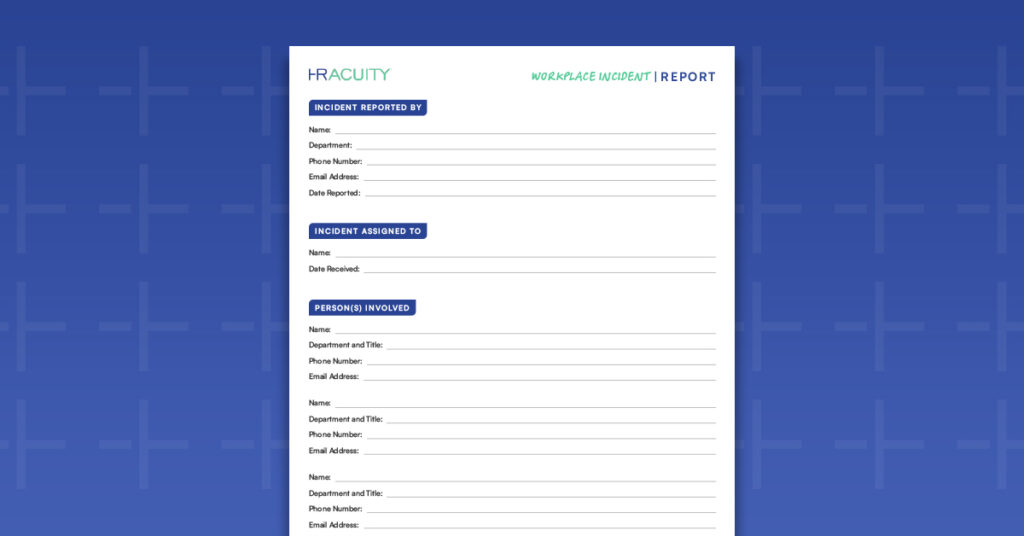Table of Contents
What is a workplace incident report?
Workplace incident reports record and document details of accidents, injuries, property damage, health and safety concerns, security breaches, and behavioral misconduct that occur in the workplace.
An incident report is a written account of the incident, including when, where, and how it happened, the individuals involved, and other relevant details – such as the nature and extent of injuries or damages.
Generally created and maintained by HR departments, workplace incident reports are vital for providing transparency across the organization, ensuring proper investigation and corrective actions are taken to prevent similar incidents in the future. As such, workplace incident reports are a key element of workplace safety, risk management, and compliance with legal and regulatory requirements at the federal or local level.
Note: You may have come across workplace incident reports before, just by a different name. Many organizations refer to this type of report as a workplace accident report or HR incident report. While we’ll focus on HR here, other departments may have similar report forms, including finance and IT teams.
What is the purpose of a workplace incident report?
Workplace incident reports aren’t just for documenting accidents, though functionally that is what they do. The purpose these reports serve is to protect individuals and the organization as a whole.
Some of the ways workplace incident reports do this include:
- Collecting detailed and accurate documentation: Incident reports provide an official account of workplace accidents and incidents, ensuring that all relevant information is recorded.
- Providing a framework for thorough, systematic investigation: Workplace incident reports facilitate the investigation process by helping HR departments analyze the circumstances of an incident, determine its causes, and take follow-up action.
- Identifying potential safety improvement: Incident reports play an important role in identifying potential safety hazards, allowing organizations to take corrective measures to prevent future incidents.
- Ensuring compliance: HR incident reports assist in meeting legal and regulatory requirements, demonstrating that the organization is committed to workplace safety and responsible reporting.
- Recording details for insurance claims: Incident reports can support insurance claims by providing a comprehensive record of the incident, which is often required for compensation.
- Protecting employees: Workplace incident reports help protect the rights of employees by ensuring that their injuries or concerns are documented and addressed promptly.
- Managing and mitigating organizational risk: HR incident reports aid in assessing and managing risks, which is essential for maintaining a safe and productive work environment.
Download your own human resources incident report template
How to write a workplace incident report
At this point you’ve learned the purpose behind creating workplace incident reports. Next we’ll dive into how to fill out a workplace incident report.
Keep in mind that different organizations will format their incident reports differently. You’ll want to keep these best practices in mind whether you use our workplace incident report template, alter it, create something new, or use an existing report.
By following these steps, you will write a well-structured workplace incident report that accurately captures the incident’s details and further the goal of maintaining workplace safety and compliance.
1. Gather essential information
To create a comprehensive workplace incident report, start by collecting all the necessary information. This includes details such as the date, time, and location of the incident, the names of the people involved, and any witnesses. Ensure you have the facts, not assumptions.
2. Describe the incident
Provide a clear and detailed description of the incident. Explain what happened, how it occurred, and any contributing factors. Use straightforward language, and avoid making judgments or drawing conclusions in this section.
3. Include injuries and damages
If there are injuries or damages involved, document them accurately. Describe the nature and extent of injuries, along with any medical treatment provided. For property damage, note the affected items and their condition.
4. Interview witnesses
Speak with any witnesses to the incident and record their statements. Ensure that their perspectives are included in the report. Collect their contact information in case further investigation is required.
5. Identify contributing factors
Consider what factors may have led to the incident. This could include equipment malfunctions, unsafe conditions, conscious malicious intent, or human error. Identifying these factors is crucial for prevention.
6. Review company policies and procedures
Ensure that your report aligns with company policies and procedures for incident reporting. This step helps maintain consistency and ensures you’re following the organization’s guidelines.
7. Attach supporting documents
If applicable, include any relevant documents, such as photographs, diagrams, or medical records to support your report. These visuals can help clarify the incident’s details. Be sure to note their inclusion, in case something gets lost.
8. Maintain objectivity
When writing the report, maintain objectivity and avoid personal opinions or emotional language. Stick to the facts and focus on what occurred rather than why it happened.
9. Follow-up and submission
After completing the report, follow up with the necessary parties, such as HR or a supervisor, and submit the report according to company procedures. Ensure it is filed in a timely manner for prompt investigation and action.
Two workplace incident types you should report
Incident reports are essential tools for documenting a wide range of unexpected events and occurrences within the workplace. By understanding when to write an incident report, you can enhance safety, risk management, and compliance efforts.
Keep in mind that not all workplace incidents occur on property belonging to the organization. In some circumstances, it is possible for workplace incidents to take place off-site or during non-working hours – during a holiday party or industry conference, for example. Incidents aren’t limited to just employees either, but might include guests, customers, prospects, or vendors. Context and circumstance matter when deciding whether or not to report. When in doubt, it is often better to write a report and not need it, than the other way around.
Here are two broad categories of events that warrant the creation of an HR incident report:
Incident category #1: Workplace hazard, natural disaster, security, and sentinel events
When something goes wrong that leads to a negative outcome, it almost certainly warrants an incident report. While we’re lumping these together, incidents in this category encompass a variety of situations, including:
- Slips, trips, and falls
- Vehicle accidents and vandalism
- Natural disasters (tornadoes, fires, disease)
- IT security breach
- Financial breach or misconduct
- Employee conflict that escalates into the threat of, or actual, physical violence or altercation
Writing an incident report for sentinel events is crucial for thorough documentation and analysis, enabling organizations to take corrective actions and prevent similar incidents. Small details matter here, so be sure to document everything thoroughly.
Incident category #2: Near misses
Near misses involve situations where no injuries or major issue occurred, but there was clear and present risk. It’s easy to ignore these types of events. Don’t. While no immediate harm was done, documenting near misses is important for identifying and addressing underlying hazards, ultimately preventing future accidents. This also demonstrates your organization’s commitment to ensure a safe workplace by encouraging employees to come forward with near miss information so it can be addressed.
Get help reporting workplace incidents with HR Acuity
No matter where you work, workplace incidents are going to happen. Or to put it another way, where there are workplaces, there are workplace accidents. Knowing how and when to document these incidents helps HR teams maintain safety and compliance, address issues, and mitigate organizational risk.
Relying on unstructured notes or recap emails opens the door to inconsistent reporting and can hamper investigations. In short, every organization needs a reliable incident report template.
Don’t have one? HR Acuity has you covered. Download your Workplace Incident Report Template here.




